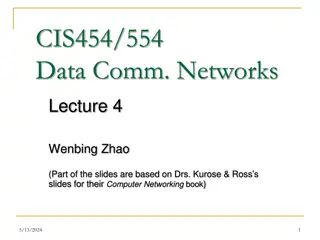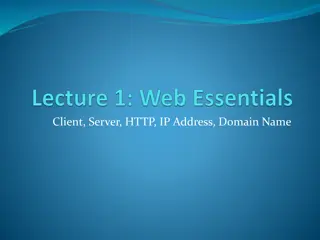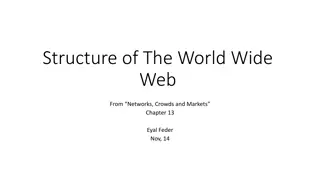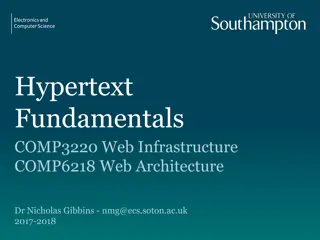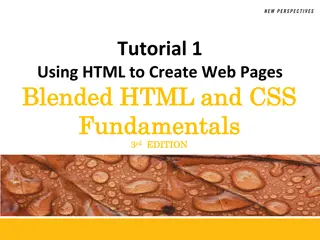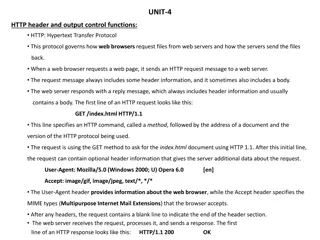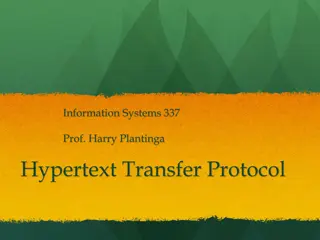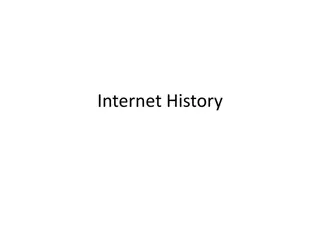Understanding HTML/CSS: Basics and Origins
HTML (HyperText Markup Language) and CSS (Cascading Style Sheets) are fundamental programming languages used in web development. HTML provides the structure of a website, while CSS is used for formatting and styling. This article delves into the origins of HTML, its evolution, the basics of HTML and
3 views • 24 slides
Introduction to Web and HTTP Protocols in Data Communication Networks
Explore the fundamental concepts of the World Wide Web and Hypertext Transfer Protocol (HTTP) as integral parts of data communication networks. Delve into the history, structure, and key components of the web, including HTML, common tags, URLs, and HTTP. Understand how information is accessed, trans
1 views • 34 slides
Understanding the Features of Online Journalism by Ganesh Kumar Ranjan
Online journalism features hypertextuality, interactivity, multimediality, and immediacy. Hypertext enables multi-linearity and multi-vocality, changing the narrative paradigm. Active reading allows readers to navigate content with flexibility, though it may challenge authors’ control. Ganesh Kuma
0 views • 7 slides
Understanding HTTP: Client, Server, IP Address, Domain Name
HTTP, or Hypertext Transfer Protocol, is a vital communication protocol that governs how web clients and servers interact. It entails a structured request-response model where a client initiates a request to a server, which generates a response. Key components include client-server interactions, IP
1 views • 15 slides
Understanding the Structure and Evolution of the World Wide Web
Exploring the intricate network of the World Wide Web, this content delves into its origins, the distinction between the web and the internet, the concept of information and social networks, and the fundamental role of hypertext. It also discusses different methods of organizing information and high
4 views • 37 slides
Understanding Hypertext Fundamentals: A Comprehensive Overview by Dr. Nicholas Gibbins
Hypertext, as defined by pioneers like Ted Nelson and Mike Sendall, is a form of non-linear writing that allows for dynamic display and branching capabilities. This concept originated in the 1960s and has evolved to become a fundamental aspect of the World Wide Web. The interactive and associative n
0 views • 33 slides
Exploring HTML and CSS Fundamentals for Web Design
Delve into the essential concepts of HTML, XHTML, and CSS in the context of creating web pages. Learn about the Internet's history, the role of web browsers, and the significance of hypertext and markup languages. Enhance your skills by studying image files, HTML tags, formatting techniques, and mor
0 views • 32 slides
Overview of HTTP Protocol and Output Control Functions
The Hypertext Transfer Protocol (HTTP) governs how web browsers request files from servers and receive responses. When a browser requests a web page, it sends an HTTP request message to the server, which includes headers and optional body content. The server responds with a message containing header
1 views • 8 slides
Understanding HTTP Basics and Common Status Codes
Delve into the world of Hypertext Transfer Protocol (HTTP). Learn about HTTP methods, response status codes, interesting headers, HTTP proxies, maintaining URLs, and form submission in web development. Explore the fundamentals of client-server communication over the web.
0 views • 11 slides
Evolution of the Internet: A Visual Journey Through Web Technologies
Explore the rich history of the internet through key technologies such as HyperText System, Gopher, Lynx, Mosaic, Netscape, Web Servers, Client-Server model, Web Hosting, Domain Name Registration, DNS Records, HTML, Firewall, HTML5 & JavaScript, and more. From early browsers to modern coding languag
0 views • 34 slides
Understanding the Architecture of the World Wide Web
The World Wide Web is a distributed information system that provides access to hypertext documents and various resources. Resources can include electronic documents, images, services, and more. The key concept in the Web architecture is the notion of resources, which need to be identified, represent
0 views • 42 slides

